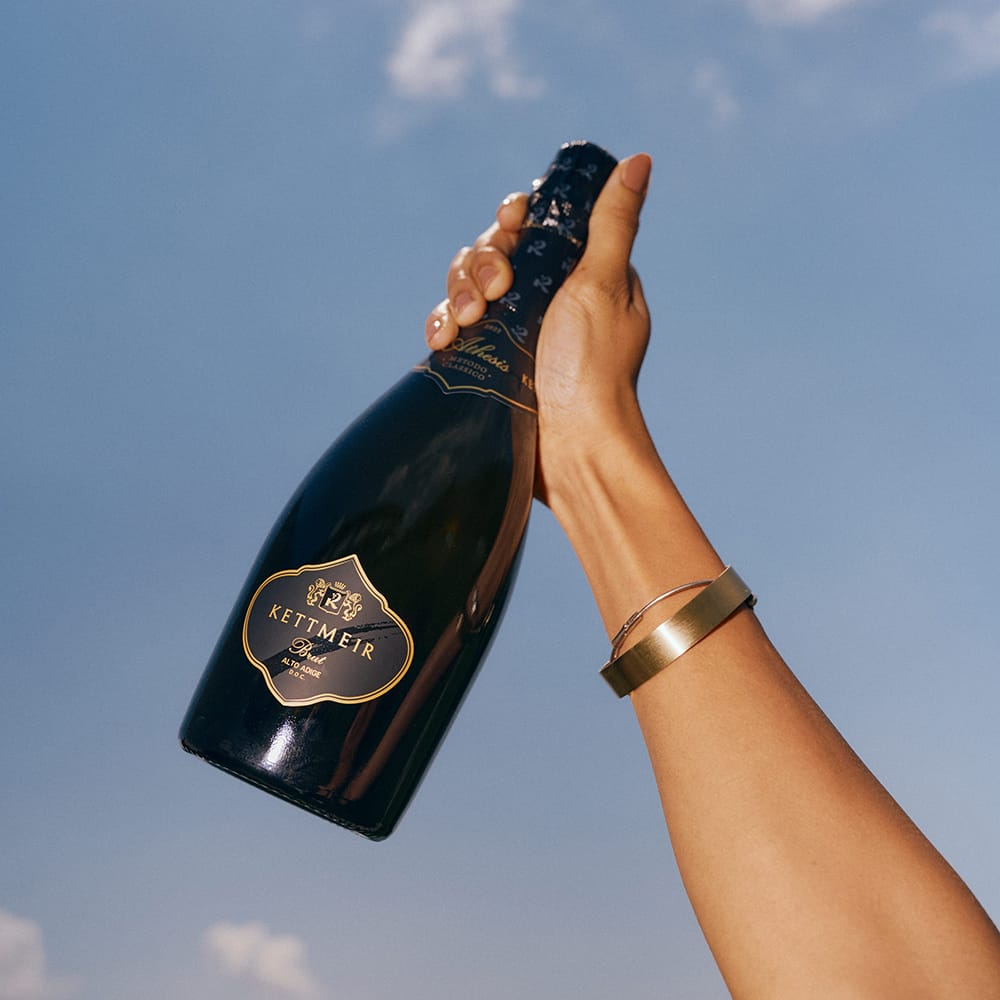K-news

The production of a Metodo Classico sparkling wine is an art that requires precision and patience. Each step in the process is essential to obtain a high-quality product with unique characteristics. Among these stages, a crucial role is played by the second fermentation triggered by the so-called “liqueur de tirage”. Let’s find out more about what this is all about, delving into the characteristics of Kettmeir’s Metodo Classico sparkling wines.
What is liqueur de tirage?
Liqueur de tirage, in Italian “‘sciroppo di tirage’“, is a mixture that is added to still base wine to induce the second fermentation in the bottle. This process is what
gives sparkling wine its characteristic bubbles and aromatic complexity. But what does the liqueur de tirage contain?
- Base wine: the base wine, obtained from the first fermentation, provides the structure and primary aromas to the sparkling wine.
- Sugars: sugars, usually sucrose, feed the yeasts during the second fermentation, producing carbon dioxide (the bubbles) and alcohol.
The amount of added sugar determines the final pressure of the sparkling wine, with approximately 24 grams per litre required to achieve a pressure of 6 bars. - Yeasts: selected yeasts, resistant to alcohol and pressure, are responsible for the fermentation of sugars and subsequent autolysis, which gives secondary aromas of bread crust, brioche etc.
Liqueur de tirage: when is it used?
The liqueur de tirage is added to the still base wine in spring, before bottling. The bottle is then closed with an aluminium crown cap and stored in the cellar at a constant temperature of 13–15 °C for approximately 5–6 weeks, during which time the second fermentationtakes place.
The role of liqueur de tirage in the Metodo Classico
Liqueur de tirage is fundamental to the production of Metodo Classico sparkling wines. The second fermentation in the bottle, triggered by its addition, gives the sparkling wine its distinctive characteristics:
- Fine and persistent perlage: the carbon dioxide produced by fermentation
dissolves in the wine, creating fine and persistent bubbles. - Aromatic complexity: during fermentation and maturation on the lees, the
yeasts release complex aromas of bread crust, yeast and dried fruits. - Structure and body: ageing on the lees gives the sparkling wine structure and
body, making it suitable to accompany a wide range of dishes.
Liqueur de tirage and Kettmeir sparkling wines
Kettmeir masterfully uses liqueur de tirage to create high-quality Metodo Classico sparkling wines such as Athesis Brut and Pas Dosé:
Athesis Brut Alto Adige DOC: this sparkling wine, with a balanced sugar dosage, offers a perfect balance between freshness and aromatic complexity. The three grape varieties are vinified separately, with gentle pressing of the grapes in whole bunches and fermentation at a controlled temperature of 14–16 °C. Ageing takes place in stainless steel tanks on the lees of the first fermentation for several months without triggering malolactic fermentation, preserving the natural acidity of the grapes.
The liqueur de tirage is then added to the cuvée, and the mixture is bottled with a crown cork and stored in the cellar at 11–12 °C. This is where the second fermentation takes place and the wine stays on the lees for about 24 months, before disgorging and subsequent marketing.
The wine has a brilliant straw yellow colour, a very fine and persistent perlage, and fruity aromas with a balanced note of yeast. The palate is fresh and dry, with excellent persistence and a pleasant aftertaste of dried fruit.
Pas Dosé Alto Adige DOC: this sparkling wine, with no added sugar after disgorging, showcases the purity of the terroir and the aromatic complexity provided by the long ageing on the lees. The grapes come from vineyards located on medium-high hills, facing west and characterised by strong temperature fluctuations, specifically intended for sparkling wine production. After gentle pressing to obtain high quality must, there is a controlled fermentation in stainless steel at 14–16 °C, followed by maturation on the lees for several months.
After the addition of the liqueur de tirage, the wine is bottled and stored horizontally in a modern wine cellar at a constant temperature of 11–12 °C, where the second fermentation takes place and the wine remains on the lees for at least 38 months. During disgorging, no liqueur d’expédition is added, but the wine is topped up with wine from other bottles to obtain a product without added sugar.
The wine has a brilliant straw yellow colour and a very fine, intense and persistent perlage. The aroma is characterised by notes of yellow flowers (broom, calycanthus) and both fresh and ripe yellow-fleshed fruit (banana, mango), with slight hints of yeast. On the palate, freshness and liveliness are supported by a fine, enveloping carbonic quality, perfectly integrated into the energetic and rounded sensation given by the long ageing on the lees. The aromatic profile of flowers, ripe and crisp fruit and herbs enhances the typically Alpine character in the lingering finish.
Discover the Kettmeir Metodo Classico: visit the online shop and be won over by the elegance and complexity of these sparkling wines.